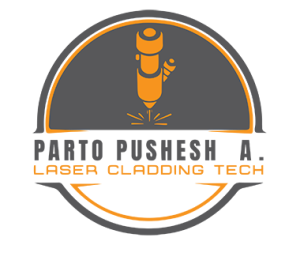Equipment for repair and reconstruction of industrial parts (cladding & 3D printing)
- KUKA multi-axis robotic system from Germany
Apadana Radiation Coating Company, in cooperation with KUKA Robotics from Germany, has designed and built a six-axis robot for laser coating operations. In this regard, Apadana Radiation Coating Company offers optimal and customized solutions for programming and automating the project. Services include the sale and support of specialized robot software, process automation, and project management.
- 6-axis robotic arm
- Repeatability of 0.04 millimeters .
- Arm movement up to a radius of 2 meters .
- Intelligent and fast movement without shake or head oscillation.
- Connectivity to the most advanced KUKA company controller.

2. 2-axis positioner
- Unlimited rotary positioning movement .
- Synchronized with the six axes of the robot arm .
- The ability to add spindle and linear tracker as the ninth axis.


- Specialized software for laser cladding and additive manufacturing
- Siemens Germany as the main controller of the device.
- Industrial Ethernet communication network.
- Fully automatic process control.
- Closed loop control mode.
- Online process simulation.
- Laser cladding and additive manufacturing software.
- Direct conversion of CAD files to robot commands.
- Simulation of the molten pool in the process.


- Optical components and specialized nozzles for laser cladding from a European brand.
1. A laser cladding head that can move inside parts and equipment with deep holes:
- Ability to coat holes with diameters ranging from 38 to 100 millimeters.
- Adjustable length of the head according to the length of the part.
- Capability to coat with various metal powders and wires.
- Option to equip the head with an industrial camera for process monitoring.

2. movable laser cladding head for inside pipes and tanks.
- Features include the ability to perform cladding in tough industrial conditions and for multi-shift operations.
- It is compatible with standard laser types and can perform cladding with various metal powders.
- The head can be equipped with an industrial camera and temperature sensor.
- Capability to equip the head with an industrial camera and temperature sensor.
- Capability to perform laser hardening process.

3. Laser coating head with a wide coating
- Capability to create rectangular coatings with widths from 6 to 30 millimeters.
- Capability to connect high-power fiber lasers.
- Significant reduction in execution time.
- Capability to equip the head with an industrial camera and temperature sensor (closed loop process monitoring and control).

4. Laser cladding head with a thin coating (coaxial nozzle)
- Capability to operate at non-90 degree angles.
- Capability to adjust laser spot size between 2, 4, 5, 6, and 8 millimeters, depending on the optical configuration of the head and the internal diameter of the fiber.
- Capability to connect high-power fiber lasers.
- Suitable for 3D additive manufacturing.
- Capability to equip the head with an industrial camera and temperature sensor (closed-loop process monitoring and control).


5.The multi-purpose laser coating head includes:
- Automatic switch between rectangular and circular laser spots.
- 2. Capability to connect various types of nozzles including three-way, four-way, dual, etc.
- 3. Ability to adjust collimator lens.
- 4. Capability to equip the head with an industrial camera and temperature sensor for closed loop process monitoring and control.

6. Types of hardening and additive manufacturing nozzles.
- 7. Laser source for laser coating.
- Fiber laser.
- It has two operational modes of continuous wave and pulsed (Multi-Function).
- High-power output with the ability to increase to higher powers.
- The ability to change the laser power during laser coating programming lines.

- Powder feeder for laser coating.
- It has two separate chambers.
- Designed and manufactured based on the volumetric principle.
- Ability to operate based on rotation of the disk (RPM) and material weight (gr/min).
- High accuracy and repeatability.
- Ability to produce composite and combined powders with a specific percentage.
- Ability to preheat powders up to 100 degrees Celsius.
- Ability to change powder flow rate during laser coating programming lines.




